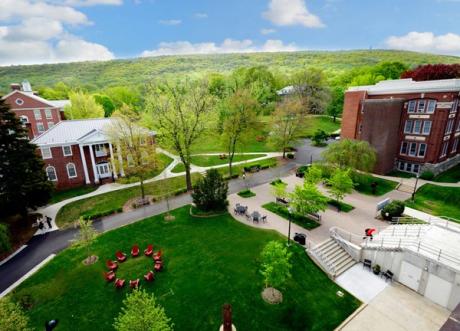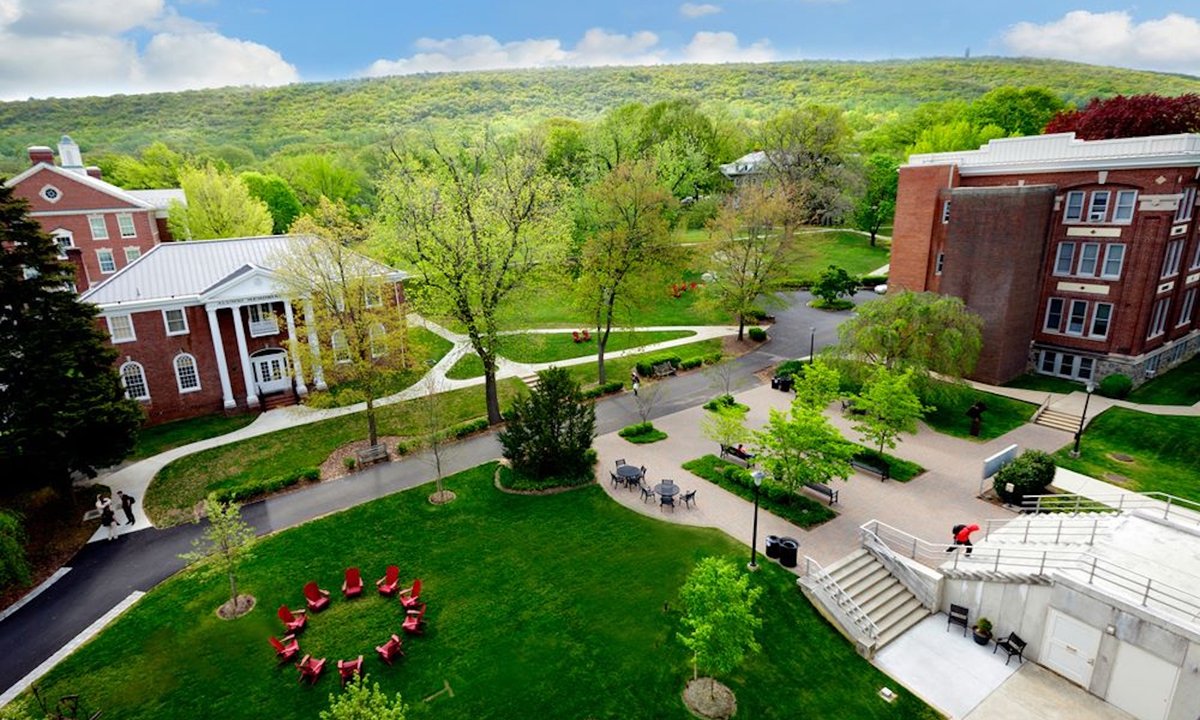
Another US university is selling its art collection to raise money and cut costs, prompting another round of outcry from the donors of this art and some others about shortchanging the experience of students. We have seen this take place at institutions including Brandeis University, Fisk University, Randolph College, Valparaiso University, Mills College and Rockford College, among others. This time, it is Albright College, a liberal arts institution in Reading, Pennsylvania, which has raided its collection of mostly works on paper to sell at Pook & Pook auction house in Downingtown, Pennsylvania.
The online-only sale on 16 July is identified only as “Fine Art from an East Coast Educational Institution”. Some of 524 lots in the sale consist of just one work, book or poster, while others include groups of art and objects, according to Dierdre Pook Margarelli, president of the auction house. It includes pieces by Karel Appel, Romare Bearden, Robert Colescott, Bridget Riley, Leon Golub, Jasper Johns, Jacob Lawrence, Marisol, Gordon Parks, Jesús Rafael Soto and Frederick Eversley, among others.
“We needed to stop the bleeding,” says James Gaddy, vice-president for administration at Albright, noting that over the past two years the college has experienced shortfalls of $20m. Calling himself and the college’s president Debra Townsley, both of whom were hired last year, “turn-around specialists”, Gaddy claimed that Albright’s 2,300-object art collection was “not core to our mission” as an educational institution and was costing the college more than the art is worth.
“The value of the artworks is not extraordinary,” he says, estimating the total value of the pieces consigned to Pook & Pook at $200,000, but claimed that the cost of maintaining the collection was high and that the cost of staffing the art gallery where the objects were displayed and (mostly) stored was “more than half a million dollars” a year.
The collection’s sale will not greatly enhance Albright’s financial future. More significant have been the layoffs of 53 salaried employees—approximately 20% of the college’s workforce—and the sale of several properties that are not “contiguous with the campus”, Gaddy says, such as a largely vacant apartment complex. The layoffs and sales have led to a $1.7m per month reduction in general operating expenses, he says, which has put the school if not in the black then at least less deeply in the red. He adds that Albright will seek to increase its current enrolment of around 1,100 students to around 1,600 by 2030, the same student population size it had as before the pandemic.
Higher pressures on higher education
Criticism of the college administration’s moves have not been absent, but they also have been relatively muted. Perhaps it is less a sign of acceptance than of resignation, at a time when federal funding for higher education has been cut severely by administration of US President Donald Trump, which has accused a number of larger research institutions of failing to curb antisemitism and is withholding tens of billions of dollars in funding until they agree to the administration’s guidelines.
The fiscal crisis at Albright College also comes at a moment when a growing number of schools of higher education across the US are being forced to close or merge with other institutions—129 since 2016, according to Higher Ed Dive. During that nine-year period, ten institutions closed in Pennsylvania alone, including Keystone College, Pittsburgh Technical College, Rosemont College and the University of the Arts in Philadelphia.
“Pennsylvania suffers from too much competition in the academic profession,” says Phillip Earenfight, a retired museum director and art history professor at Dickinson College and a current board member of the Association of Academic Museums and Galleries (AAMG). “They can’t all attract enough students. They are competing in an environment in which they cannot all survive.”
Colleges and universities selling valuable objects from their collections to close budget gaps or to improve on-campus facilities “has been going on for a number of years now, and we’ve certainly seen an escalation in the past few years”, says Lynn Pasquerella, president of the American Association of Colleges and Universities. She rejected the idea that individual institutions must choose between educating students and maintaining and developing museum collections on campus, preferring that colleges “work collaboratively” to strengthen all areas of the academic experience, citing the 2022 affiliation of Antioch and Otterbein universities in Ohio and the Five College Consortium in western Massachusetts, which dates back to 1965, which allows students from Amherst College, Hampshire College, Mount Holyoke College, Smith College and the University of Massachusetts to take courses at each other’s schools.
Maxwell L. Anderson, the former director of the Whitney Museum of American Art and currently president of Souls Grown Deep, similarly states that an alternative to selling the collection is possible, as “there may be room for a solution like that followed by the Corcoran Gallery of Art” in Washington, DC, which closed in 2014, transferring its school to George Washington University and parcelling out its art collection among several area institutions. He recommends that Albright identify “one or more other museum collections interested in shouldering responsibility for the collection. While an imminent auction of lesser works is slated to take place this month, the balance of the collection appears to be in play.”
Mixed reactions
A number of associations involving museums, such as the AAMG, the American Alliance of Museums and the Association of Art Museum Directors, have rules or guidelines for members stipulating that proceeds derived from deaccessioning and selling objects from an institution’s permanent collection be used solely for the purpose of acquiring additional pieces. Albright College, however, is not a current member of any of those groups, and its dispersal of its collection would make any actions to discipline it for breaking the rules irrelevant.
Selling off objects from a permanent collection for other reasons than new acquisitions “is not surprising when it takes place primarily at private colleges and universities, which are more vulnerable” to budgetary shortfalls and do not have large endowments, says Katie Lee-Koven, the executive director and chief curator at the Nora Eccles Harrison Museum of Art at Utah State University and a board member of AAMG.
Albright College’s art collection came from a variety of sources, but the lion’s share comes from the New York City art dealer Alex Rosenberg (1919-2022) and Doris C. Freeman (1928-81), the first director of New York’s Public Art Fund, who also served as New York City’s first director of cultural affairs—both of whom were alumni of the college.
The collection has been displayed in what was named the Doris C. Freedman Gallery, and it was the intention of Freedman to “create a space where the arts would flourish—a space for students and the community to engage with the arts”, according to a letter sent by the donor’s three daughters (Susan, Karen and Nina) to the college’s legal counsel, Courtney Schultz. They added that “Albright’s decision to monetise the art collection of the Freedman Gallery is both shortsighted and counterproductive. The sale of these treasures can do nothing meaningful to mitigate Albright’s $20m debt.”
The letter asks that the college reconsider its decision to sell the artworks at auction, hinting at but explicitly not declaring an intention to sue Albright (“we will explore our alternatives”).
Few voices have been raised in the college’s community to criticise the administration’s moves. Some who did complain, such as David Tanner, dean of arts and cultural resources, and the gallery’s art preparator Rich Houck, were fired. John R. Pankratz, a professor of history at Albright, claims that Gaddy had brought up to Tanner the idea of deaccessioning the collection. Pankratz says: “Tanner said ‘over my dead body,’ and that ultimately is what took place.”
Others will find little to miss with the selling off of these works. “I don’t know what the collection contains or how it is used in arts education at Albright,” says Mark Baldridge, an assistant professor in the college’s art department. Pankratz says the collection was “not well related to the college” since few instructors in art history or any other department made the works integral to their curricula. He adds: “There was a nice Salvador Dalí sculpture and some lovely Romare Beardens, but otherwise there were no masterpieces in the collection.”


















